#Principat de Catalunya
Text
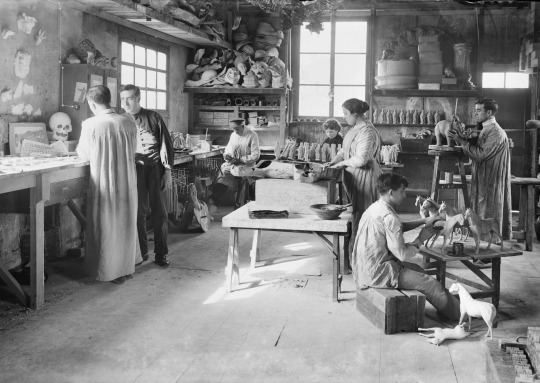
Interior d'una fàbrica de joguines a Barcelona. Fons Brangulí, 1914.
La fàbrica no feia només joguines, sinó també figures de pesebre i d'altra mena. Més enllà de la gran qualitat artística de la fotografia, que sembla un posat o una obra teatral, cal fer notar el diari El Poble Català, que podeu veure a l'esquerra de l'escena, sobre la taula, amb el titular «La guerra europea».
Més fotografies del lloc:
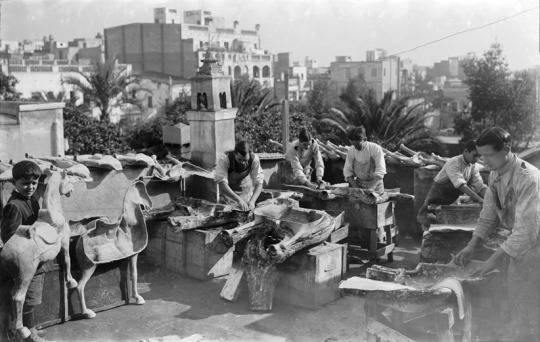



#art#fotografia#Fons Brangulí#joguines#fàbrica de joguines#fàbrica#factoria#Barcelona#Catalunya#Principat de Catalunya#El Poble Català#catalans#1914
4 notes
·
View notes
Text

Comparteixo aquesta il·lustració que he vist a l'Instagram perquè m'ha agradat molt 💙 (tot i que hi hagi un error amb l'escut que utilitza pel català)
Enllaç al compte de l'il·lustrador lleonès Don Recaredo, que té moltes obres sobre la cultura lleonesa i en estil medieval.
#considero que el català hauria d'haver tingut la senyera (que és l'escut dels comtes de Barcelona. l'Aragó el va adoptar al casar-se amb#el comtat de Barcelona) i no l'escut de la ciutat de Barcelona#és un error però entenc que ho han fet per no repetir símbol#tot i que l'escut de la ciutat de Barcelona no representa a ningú més que a la ciutat de Barcelona i la senyera és significativa de tot el#principat de Catalunya#crec que hagués sigut millor repetir dues senyeres iguals per Catalunya i l'Aragó si l'Aragó no té cap altre símbol propi (que desconec#(però suposo que no pq sinó les hagués utilitzat? però alguna cosa devien tenir abans d'agafar l'escut del comtat de barcelona no?)#de tota manera és una il·lustració molt maca ☺️#l'estil i el cel amb les estrelles m'encanten#art#history#galego#asturianu#llionés#castellano#euskara#aragonés#català#💬
20 notes
·
View notes
Text
UPDATE: THE CATALANOARAGONESS CROWN IS NOW A THING™
ft. RB IV
also known for finishing his father's conquests. the Principat de Catalunya is now a thing™
1 note
·
View note
Text
Catalònica: una finestra oberta al patrimoni cultural de Catalunya
Recentment ha estat reconegut com a agregador oficial d’Europeana, i és l’únic de caràcter territorial que no correspon a un estat.
Vrients, Jan Baptist. Cataloniae Principatus novissima et accurata descriptio. 1608. (Mapa del Principat de Catalunya de 1608, obra de Jan Baptist Vrients, que es pot consultar a la plataforma Catalònica). ICGC
Saps què és el Catalònica? És un portal web impulsat per…
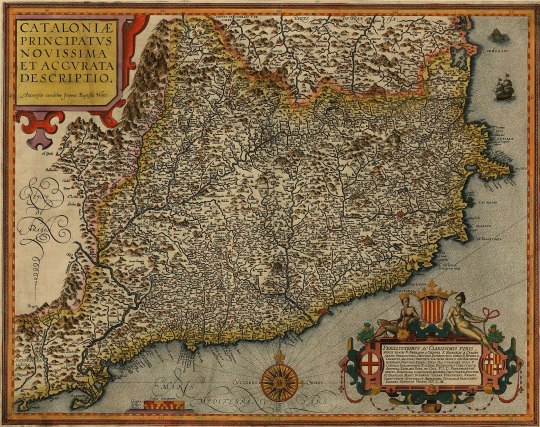
View On WordPress
0 notes
Text
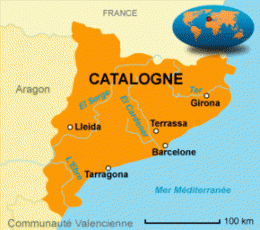
LA CATALOGNE (en catalan Catalunya; en occitan Catalonha) est une nacionalité du nord-est de la Péninsule Ibèrique. Sa capital et métropole est la ville de Barcelone. Elle est entourée par la Royaume de València (au sud), l'Aragon (a l'ouest), la France (nord Catalogne; au nord), l'Andorre (au nord ouest), et la mer Méditerranée (a l'est). Una partie de ses terres fait donc frontière avec la Repúblique Française. Elle couvre une superfície de 31.950 km2 et, en 2021, comptait 7.508.106 habitants. Ses langues officielles sont le catalan, l'occitan (en Val d'Aran) et le castillan. Après douze ans, à faire partie de l'Assamblée Parlemantaire de la Francophonie (APF) en tant que membre observateur, le Parlament de la Catalogne a changée de statut (26 janvier 2021). Desormais la Chambre des Parlamentàries catalans devien membre associés de cette organisation internacionals et obtien un droit de vote los de les délibérations. APF travaille activament a la promotion de la democràtie et de l'Estat de droit dans l'éspace francophone. L'ancién president independentiste (Roger Torrent) a profit de la réunion télématique de la Comission Polítiques de l'AFP pour denoncer -segon lui- la répresion polítique en Catalogne et réiteré son engagement en faveur de l'autodétermination et le referèndum comme moyen de resoldre le conflit polítiques Catalogne/État espagnol. La Catalogne est également la plus peuplée parmi les País Catalans, un ensemble culturel et lingüístiques que la lie avec la communotée Valencienne, les îles Baléares, la Principat d'Andorre, l'Alguer en Sardaigne, et la "franja" aragoneses et à l'essencial du départament français des Pyrénées Orientales. La Catalogne est née en tant que réalité nacional par la réunion polítique de plusieurs comtes de l'ancien Marche Ibèrique Carolingienne sus l'autorité de la Maison de Barcelone. La Principaute de Catalogne ainsi constituée devient progressivament un État a la fin du Moyen Âge, avec ses institucions comme les "Corts", sont droit hérité du droit romain, wisighotique et feudal et compilé dans les "Usatges", ou encore sa langue, le catalan, qui se constitue en langue administrative juridique et littéraire a partir du XII siécle. Par le system e politique de monarchie pactiste, la Catalogne conserve ses spécificités et privilèges institutionnels, coutumiers et jurisdictionnels, appelés "Constitutions et d'Autres Droits" au sein de la Couronne d'Aragon (puis du royaume de l'Espagne), jusqu'aux decrets de "Nueva Planta" (1715) qui, après une longue guerre et la conquête de Barcelone par les armes franco-castillanes, abolissent toutes les institutions catalanes. Après le mouvement de renouveau de la langue et de la culture catalane (interdite par la nationalisme espagnol le plus sauvage), le "catalanisme" se structure idéologiquement a la fin du XIXe siécle, tandis que la Catalogne est l'une des rares regions peninsulaires Ibèriques a connâitre alors une importante révolution industrielle. De même, le mouvement artístiques du modernisme témoigne de l'ouverture sur l'Europe de la nation catalane ainsi que du nouveau rayonnement culturel que connaît ce territoire. La Catalogne fait partie depuis 1988 des "Quatre Moteurs" pour l'Europe avec Baden-Wurtemberg, Lombardie et Auverge-Rhône-Alpes.
0 notes
Text
Castell de Llívia
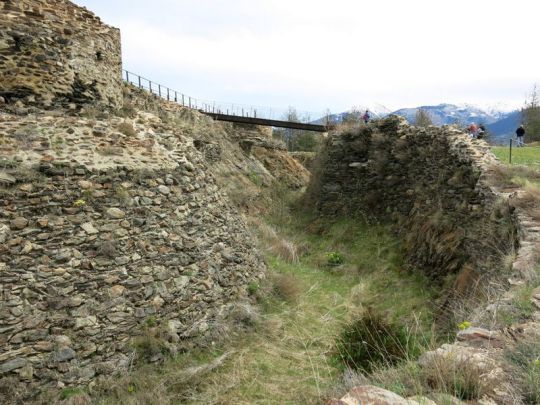
Iulia Lybica va ser una de les ciutats que els romans van fundar a una de les serralades on més oposició van trobar a la seva expansió als territoris dels íbers i altres pobles que ocupaven el que ells van identificar com a terra de conills.
Les muntanyes del nord de la Península Ibèrica, des del Cantàbric fins als Pirineus van acollir pobles irreductibles davant el poder romà: asturs, càntabres, vascons i d’altres d’arrels ibèriques com els ceretans, que eren els antics pobladors de l’actual Cerdanya.
El principal nucli poblat de Cerdanya va ser la moderna Llívia, gràcies a la protecció que li proporcionava la muntanya que la flanquejava. Al que avui és anomenat turó aviat s’hi van instal·lar els primitius pobladors buscant una posició favorable per protegir-se dels possibles enemics.
Es té constància de la ocupació del seu cim des del segle IV i és documentat un castrum Lybiae el 672 durant la revolta del duc Paulus contra el rei visigot Vamba, que demostra que aquest poble germànic hi va tenir una llarga presència -a excepció de l’efímera ocupació islàmica- que es va perllongar gràcies als nobles gots que —sota la protecció de l’Imperi carolingi- van fundar els primers comtats catalans, com el de Cerdanya, que Sunifred I va regir durant el segle IX.
No obstant, el castell de Llívia és documentat per primera vegada el 996, més de segle i mig després de la instauració de la dignitat comtal ceretana i des d’aquell moment, la posició fronterera amb la pressió cada vegada més forta dels veïns francesos va fer que el castell adquirís cada vegada més importància.
Les conteses bèl·liques al llarg de la frontera entre la Corona d’Aragó i el Regne de França van anar pujant de to durant l’Edat Mitjana i un dels moments cabdals va ser la creació del Regne de Mallorca, al que pertanyien els comtats de Rosselló i Cerdanya.
La supervivència del regne illenc al segle XIV va dependre en algun moment del recolzament dels francesos, ja en oberta oposició als catalano-aragonesos, que havien reincoporat els territoris mallorquins i pirinencs mentre la dinastia secundària del Casal de Barcelona lluitava per mantenir el seu reialme.
Al segle XV, la guerra civil catalana (1462-1472) va fer que el rei Lluís XI de França s’hi impliquès fent costat a Joan II d’Aragó, la qual cosa va suposar l’empenyorament del Rosselló i la Cerdanya al monarca francès.
La revolta estava servida i el castlà de Llívia, Damià Descatllar, d’una nissaga que en va ostentar el càrrec des del 1362, es va aixecar contra Lluís XI. El 1478, els francesos van assetjar el castell durant més d’un any. Després de la capitulació, el rei francès va fer enderrocar-lo el 1479.
De la importància de l’emplaçament del castell de Llívia dóna fe l’intent de reconstrucció que es va dur a terme durant la guerra dels Segadors (1640-1659), entre la Generalitat de Catalunya i el rei Felip IV d’Habsburg.
De la fortalesa de Llívia només queden els fonaments de les seves muralles i de la seva estructura quadrada amb les seves torres circulars a les cantonadaes, aixó com el seu fossar. La seva importància i l’èxit de la seva funció defensiva d’una de les entrades al Principat de Catalunya va ser la seva sentència de mort.
Foto: Creative Commons.
0 notes
Text
Llívia, a castle that died of success

Iulia Lybica was one of the cities that the Romans founded in one of the mountain ranges where they encountered most opposition to their expansion in the territories of the Iberians and other peoples who occupied what they identified as country of rabbits.
The mountains in the north of the Iberian Peninsula, from the Bay of Biscay to the Pyrenees, were home to peoples who were unyielding to Roman power: Asturians, Cantabrians, Basques and others with Iberian roots, such as the Ceretans, who were the ancient inhabitants of what is now Cerdanya.
The main settlement in Cerdanya was modern Llívia, thanks to the protection provided by the mountain that flanked it. The primitive settlers soon settled on what today is called a turó (hill), seeking a favourable position to protect themselves from possible enemies.
There is evidence of the occupation of its summit from the 4th century and a castrum Lybiae is documented in 672 during the revolt of Duke Paulus against the Visigoth king Wamba, which shows that this Germanic people had a long presence - except for the ephemeral Islamic occupation - which was prolonged thanks to the Gothic nobles who - under the protection of the Carolingian Empire - founded the first Catalan counties, such as that of Cerdanya, which Sunifred I ruled during the 9th century.
However, the castle of Llívia is documented for the first time in 996, more than a century and a half after the establishment of the Ceretan count's dignity, and from that time onwards, its position on the border with the increasingly strong pressure from its French neighbours meant that the castle became increasingly important.
Warfare along the border between the Crown of Aragon and the Kingdom of France increased in intensity during the Middle Ages and one of the key moments was the creation of the Kingdom of Mallorca, to which the counties of Rosselló and Cerdanya belonged.
The survival of the island kingdom in the 14th century depended at some point on the support of the French, who were already in open opposition to the Catalan-Aragonese, who had reincorporated the Mallorcan and Pyrenean territories while the secondary dynasty of the Casal de Barcelona struggled to maintain its kingdom.
In the 15th century, the Catalan civil war (1462-1472) led King Louis XI of France to get involved in supporting Joan II of Aragon, which meant the cession of Rosselló and Cerdanya to the French monarch.
The revolt was on the cards and the Earl of Llívia, Damià Descatllar, from a family that had held office since 1362, rose up against Louis XI. In 1478, the French laid siege to the castle for more than a year. After the capitulation, the French king had it demolished in 1479.
The importance of the site of the castle of Llívia is attested to by the attempt to rebuild it during the Reapers' War (guerra dels Segadors, 1640-1659), between the Generalitat de Catalunya and King Felipe IV of Habsburg.
All that remains of the fortress of Llívia are the foundations of its walls and its square structure with its circular towers at the corners, as well as its moat. Its importance and the success of its defensive function as one of the entrances to the Principat of Catalunya was its death sentence.
Foto: Creative Commons.
1 note
·
View note
Photo

Cava i Placa Conmemorativa de L'1 d'Octubre de 2017. Un excel·lent Cava Brut Reserva de Sant Sadurní d'Anoia. Criança de 5 anys. Disponible a www.cavaartistic.cat o bé truca'ns al 669850825 i te'l portem personalment a casa. #1714 #tv3 #covid_19 #1d'octubre #republica #catalunya #independència #cava_artistic #cavaartistic #puigdemont #paisoscatalans #larocavillage #Elmeu1O #freedom #freedomforcatalonia #canigo #catalanrepublic #republicacatalana #catalunyalliure #principat #retornexiliats #mhppuigdemont #nosurrender #freetothom #llibertat #cava #brutreserva #celler #diada https://www.instagram.com/p/CXtWYtItoIR/?utm_medium=tumblr
#1714#tv3#covid_19#1d#republica#catalunya#independència#cava_artistic#cavaartistic#puigdemont#paisoscatalans#larocavillage#elmeu1o#freedom#freedomforcatalonia#canigo#catalanrepublic#republicacatalana#catalunyalliure#principat#retornexiliats#mhppuigdemont#nosurrender#freetothom#llibertat#cava#brutreserva#celler#diada
0 notes
Text
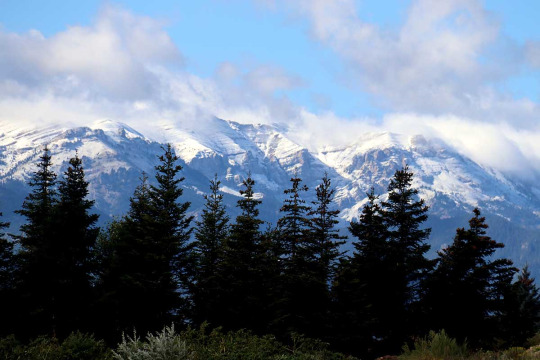
El Cadí, Pireneus catalans, Principat de Catalunya.
#Cadí#Pireneus#Pireneu#Pirineus#Pirineu#Principat de Catalunya#Catalunya#muntanya#muntanyes#paisatge#paisatge muntanyenc#paisatge hivernal#hivern#hivernal#neu#nevat#nivós#cims nevats
3 notes
·
View notes
Photo

Repost @aliga.sabadell ---------------------------------------- Últimes entrades a l'enllaç de la bio. No et quedis sense conèixer l'ÀLIGA DE SABADELL. L’acte comptarà amb la presència de la imatgeria de la Colla de Geganters i Grallers de Gràcia així com de quatre àligues, una de cada província de Catalunya, representant així tot el principat. Faran de padrines l’Àliga de Mataró i l’Àliga de Tàrrega, i com a convidades l’Àliga de Girona i l’Àliga de Tortosa. També comptarà amb altres figures del nou Seguici Festiu de Sabadell, el Lleó de Sabadell, la Víbria de la Creu Alta de Sabadell i els Gegants de Sabadell. #quenothoexpliquin #vine #reservalatevaentrada #10dejuliol #estrena #àligadesabadell #culturapopular __________________________ #AligaDeSabadell #AligaDeCatalunya #AliguesDeCatalunya #AliguesDeCat #Aliga #Aguila #Aguiles #Aligues #CulturaCatalana #FestesDeCatalunya #BestiariPopular #FiguresZoomorfiques #ImatgeriaFestiva #CulturaPopular #BestiariFestiu #BallDeLAliga (en Sabadell) https://www.instagram.com/p/CRD2Aw1reps/?utm_medium=tumblr
#quenothoexpliquin#vine#reservalatevaentrada#10dejuliol#estrena#àligadesabadell#culturapopular#aligadesabadell#aligadecatalunya#aliguesdecatalunya#aliguesdecat#aliga#aguila#aguiles#aligues#culturacatalana#festesdecatalunya#bestiaripopular#figureszoomorfiques#imatgeriafestiva#bestiarifestiu#balldelaliga
0 notes
Text
Catalan Folk Music
As per request, your favorite old person is here to give you some Catalan folk recommendations! (Actually I am neither old nor do I listen to large amounts of Catalan folk, but whatever, I’ll take any opportunity I get to talk about Catalan music.)
To begin with, the idea of “folk music” is kind of hard to define, since “folk” basically just means people and people are behind music most of the time. I’m not sure what Catalan folk Spotify thinks I’m listening to, but I’ll break down what I consider to be folk music from Catalunya and y’all can decide which one you think most accurately describes the style you like.
(this is officially Too Long so will continue under the cut)
Real Folk (aka Weird Songs Your Avis Would Sing About Jesus and Other Such Topics)
Beldà + Sanjosex - This is probably why Spotify thinks I enjoy Catalan folk, but this album is really cool for me because as the child of an ethnomusicologist one of my favorite things in the world are the original songs that people used to sing in different places aka Real Folk Music™, and this album is the epitome of that. Neither Carles Beldà nor Sanjosex are explicitly folk artists, so don’t listen to any of their other albums expecting them to be the same, but this one is basically them reviving traditional Catalan folk songs (including samples from original recordings) and I think it’s super cool. If you speak Catalan, there’s a website (called Càntut like the album) dedicated to preserving these sorts of songs, with a wealth of songs, lyrics, and recordings.
“El divino vull cantar” - Token Jesus song with one of the people who taught them the song featured at the beginning and end (and at the end he sings a verse that Sanjosex comments is one he had never heard before).
“El pomeró” - A cute song about a little apple tree of the sort that you would sing as a child except in a pretty polished version.
“Serrallonga” - A song about everyone’s favorite Catalan folk hero, this one has a bit more of an edge to it because Serrallonga was an edgy man.
Pep Gimeno “Botifarra” - I don’t know if Pep Botifarra should be here because he kind of transcends categories, but this was the best I could do. Basically, he’s a traditional singer in the Valencian cantaor style, and he makes a lot of traditional but also fun and modern music! In other words, the style he sings in is always traditional, and generally he’s accompanied by a traditional ensemble, but he also appears in collaboration with a range of groups from the País Valencià and the Països Catalans in general, especially groups like Obrint Pas. Also, a lot of his songs have more modern lyrics, and he’s generally just amazing.
“Malaguenya de Barxeta” - A rousing hymn to “el meu País Valencià” and honestly just The Best. Obrint Pas also have a version of this, which is also great, but less traditional.
“Jota de Xàtiva” - Feliu Ventura wrote at least some of the lyrics to this, but the music is old, which makes for a fun mix between modern and traditional.
“Cant de batre” - Just because it’s absolutely gorgeous, not because it’s famous or important.
Nova Cançó (aka The Kind of Folk That Came From the 60s and Was Mostly For Hippies but in Catalunya It Was a Bit More Rooted In Actual Tradition)
Lluís Llach - I actually don’t listen to much Llach, but how can I not include him on this list? I don’t know if I would consider him 100% folk, but he’s definitely a leader of the Nova Cançó movement and a Catalan musician who you just can’t not know.
“L’estaca” - THE song by Lluís Llach, also probably a good example of him singing in a more folk-y style.
Maria del Mar Bonet - I've only listened to a bit of Maria del Mar Bonet, but she was another leader of Nova Cançó and her songs are really pretty and a lot more folksy. She’s also from Mallorca, which is always fun.
“Merhaba” - A song about the unity of Mediterranean cultures and their shared history as seafarers. This version sounds like it came from a movie soundtrack but it’s great.
“Què volen aquesta gent?” - A song about political repression and persecution during the dictatorship. It’s pretty famous and very moving.
“Carta a l’exili” - A song about writing to people from exile, making a definite reference to all the Catalans exiled after the Spanish Civil War and during the dictatorship.
Al Tall - Al Tall are THE folk band from the País Valencià, even though they kind of don’t count as Nova Cançó. They sing a lot of really traditional Valencian songs, but as with a lot of these groups, some of them have a definitively anti-Spain and anti-Bourbon flavor (I’m looking at you, “Cant dels Maulets”). Also they use a lot of dolçaina, so if that annoys you then you’re probably not going to like them. Still, if you want folk from a certain era from Valencia, they are your go-to people.
“El cant dels Maulets” - I can’t not mention this song, sorry if you like the Bourbons but this is a legend and it deserves to be here.
“Cançó de la llum” - A good song about a town where the mayor is supposed to switch to electricity but siphons the funds away for other purpose and proceeds to get absolutely destroyed.
“Tio Canya” - I’m sorry but it’s kind of impossible to find a non-political song by Al Tall, this one is about the loss of the Valencian language and is probably one of their most famous.
Ovidi Montllor- Ovidi is also Nova Cançó and arguably does not count as folk but I don’t care because he’s amazing and y’all should listen to him. He’s very left-leaning and pro-Valencian/Països Catalans, so he’s basically eternally relevant to young Catalans and honestly to young people everywhere, which is why groups like Aspencat, La Gossa, El Diluvi, and even Txarango (see the opening line of “Agafant l’horitzó”) make constant references to him.
“Perquè vull” - A classic. The ultimate petty song but honestly such a mood. This version featuring Ovidi speaking in French at the beginning.
“Homenatge a Teresa” - Not personally my favorite Ovidi song, but it’s legendary so I can’t not put it. It’s a lot more quiet and gentle than his other songs.
“Tot explota pel cap o per la pota” - This is not the most Communist song by Ovidi, but it’s probably up there. Basically just about how the proletariat is done with the bourgeoisie, is empowered, and is going to rise up. What more could you ask for?
Raimon - Another super important artist from the País Valencià who is a bit more rooted in folk than Ovidi but still a part of Nova Cançó. I haven’t listened to a lot of Raimon but songs like “Al Vent” are classics that you can’t not like.
“Al vent” - A song about fighting despite the darkness of the world we were born into. It’s absolutely gorgeous.
“Jo vinc d’un silenci” - A haunting song about remembering where you come from and not losing sight of your roots.
“D’un temps, d’un país” - A solemnly beautiful song about pushing on and slowly winning the world that we have fought so much to see. Interpret what that world is as you will.
Esquirols - If you have an image of folk from the 1960s, Esquirols are probably what you’re imagining. Basically just a bunch of hippies singing songs about joining together (and also fighting for Catalunya but I mean what else would you expect at this point). In my opinion the best group from the Principat during this era, but that’s entirely personal and I am usually a bad judge of these things.
“Torna, torna, Serrallonga” - It’s ya boy he’s back and also this is literally The Most Legendary Song Ever it’s so epic (and as a heads up it’s also exceedingly political).
“Fent camí” - This is basically the Catalan version of all the songs I grew up with from Rise Up Singing (aka just a book with all the pro-union/grassroots protest songs ever sung in the United States), which is not a thing anyone is going to know but I don’t know how else to describe it.
“Arrels” - I just posted this a week or so ago (albeit a different version) but it’s so pretty and just a really nice positive song about life in general except not in a cheesy way, it’s just gorgeous and you have to listen to it for yourself.
“Folk Calentó” (aka Catalans Are Great and Have Modern Cool Hip Bands Who Play Folk in a Fun Way That Is Enjoyable to Listen to)
Roba Estesa - This band is literally the most undervalued Catalan group in modern music. They are six women who basically sing either feminist adaptations of traditional songs or else original songs with lots of influences from cúmbia or rumba catalana, but still with a definitive folk feel. They are amazing and deserve much more love than they get.
“Una altra ronda” - A lively song about getting really drunk with your friends because screw the rules women don’t care about being well-behaved.
“A la muntanya” - An older song about how girls just wanna have fun screw their husbands.
“Les noies d’Olot” - More girls just being generally badass and too good for the men who are interested in them.
El Diluvi - Of a similar left-leaning, feminist vein to Roba Estesa, this group is also very Catalanist and big fans of Ovidi (see above). They have a lively folk sound, with influences from all around the world, but are definitely rooted in acoustic, with a violin and a bandúrria making up part of their ensemble. They are quite possibly one of my favorite Catalan groups of all time.
“I tu, sols tu” - A feminist hymn but also just a great song, based on a poem by Maria Mercè Marçal.
“Vell record” - More of a folk song, with a somewhat Celtic sound and vivid lyrics.
“Alegria” - A simple, happy song about being happy. (What would expect, given the title?)
Germà Negre - A group which claims they were formed when La Moreneta (patron saint of Catalunya) visited them in a dream and told them to revive traditional Catalan music, which regardless whether it’s true or not, is a good origin story. They mostly sing covers of other artists (including songs by several of the artists listed above), but they have lots of interesting instruments and I really like them.
“L’Hereu Riera” - I am personally a fan of this version of this song, even though I’m pretty sure no one else knows it exists. The video shows the traditional dance that goes along with it as well as the cobla, the traditional Catalan musical ensemble.
“Les noies maques” - A great cover of a Catalan kids’ song that is about 200 times better than the original (even though the video does not match with the music being played, which is annoying).
“Guarda la lluna” - A more traditional song, but it’s really lively and energetic.
La Troba Kung-fú - Probably a stretch, but rumba catalana is definitely folk music, and La Troba are masters of it. They definitely have a lot of modern influences from reggae and other things, but they do some really fun versions of traditional songs, which is what I’ll put here.
"La cançó del lladre” - The definitive version of this traditional song, very rumbero and very good, albeit perhaps not the most folk-like song.
“El preso de Lleida” (with Sílvia Pérez-Cruz) - A beautiful rumba version of this traditional Catalan song, with Sílvia Pérez-Cruz, who is another amazing folk-ish singer. It’s kind of quiet in the beginning, so turn up the volume.
“Flor de primavera” - Not a traditional song, but a gentle, beautiful rumba that is so dreamy and light you will immediately fall in love with it.
Indie Folk (aka The Acoustic Airy Sound That You Probably Associate With Folk More Than Anything Else on This List)
Mazoni - I haven’t listened to everything by him, but a lot of his music is what I would consider folk in the current sense of the word, especially his latest album. He is very much defined by that acoustic guitar sound, but can also be wildly different, so it’s hard to say with him.
“La collita” - A fun song about the apocalypse that takes a dig at Goldman Sachs, which is always appreciated.
“Pedres” - I personally really enjoy this song, it’s a bit grittier and more intense than the simple melody would seem.
Cesk Freixas - While I would consider Cesk Freixas more singer-songwriter than explicitly folk, he definitely has that specific sound. I haven’t really listened to much by him, but here are a few songs that aren’t “La petita rambla del poble sec” even though I love that song, plus him doing a cover of some of the songs earlier on this list.
“Et dono casa meva” - A mix of singer-songwriter and folk, a love song to Catalunya and the Països Catalans.
“Que no et falli mai la sort” - A good example of his unique brand of utopianism and hope for the future, which sounds silly but it’s honestly not.
“Al vent / L’estaca / Què volen aquesta gent?” - Cesk’s version of these three classics which you might recognize now :))))
Well, this ended up being more of a list of traditional Catalan music than Catalan folk music, but that’s more of what I listened to. This also turned out way too long, but am I even capable of writing short posts? Anyhow, enjoy!
#i spent all day on this bc i have no life#but it was fun#also i grilled my father on what folk music is#and he said that roots music was more traditional than folk#but this is what i think folk is so this is what you're getting#also we had the same initial definition which is that it's the stuff they play on our local folk radio station#but that doesn't help explain it to anyone else#anyway this is here#music#catalan#general:music#catalan:music#catalan:culture#catalan:general#catalan:reference
16 notes
·
View notes
Text
Fortaleza de Monzón

La fortalesa de Monsó és probablement d'origen musulmà, doncs els àrabs que van escombrar el regne visigot de la Península Ibèrica s'hi van establir només tres anys després de creuar l'estret de Gibraltar, cap al 714.
Les vicisituds del territori comprès entre el Baix Cinca i la ciutat d'Osca va fer que durant prop de tres segles fos escenari de lluites entre diverses famílies d'origen àrab: els Banu Qasi i els Banu Amrus entre elles. La caiguda de la comarca en mans del rei aragonès Sanç Ramires (Sancho Remíriz, en aragonès) el 1089 va marcar el futur del castell.
En aquesta època, es va situar a la frontera entre el regne aragonès i els comtats de Barcelona i Urgell, i quan el 1137 el comte Ramon Berenguer IV de Barcelona va esdevenir príncep d'Aragó pel seu matrimoni amb l'infanta Peronella (Peironela, en aragonès), Monsó acaba passant a mans de l'orde dels Templers.
És en aquest context quan, després de la mort del rei Pere el Catòlic a la batalla de Muret davant dels exèrcits francesos comandats per Simó de Montfort, el castell fortalesa esdevé presó. Els templers hi van custodiar el rei minyó Jaume durant tres anys, del 1214 al 1217 dins les seves muralles.
El futur Jaume I el Conqueridor va compartir captiveri amb el seu cosí Ramon Berenguer V de Provença a Monsó, sota la tutela del gran mestre templer Guillem de Montredon. Sembla que els anys de reclusió en aquesta fortalesa van forjar el caràcter i el sobrenom: va conquerir els regnes de Mallorca i València, i va casar-se tres vegades i es diu que va tenir forces amants.
El bastió templer que va acollir a Jaume I va convertir-se en objecte del desig pel seu descendent Jaume II, qui el va atacar el 1309 després de l'ordre de dissolució dels Templers dictada pel Papa Climent V.
L'estructura actual del castell mostra les reformes sofertes durant segles, però sobre tot les del segle XVIII, després que la Guerra de Successió fes necessària una presència militar a la frontera entre els ja dissolts territoris del regne d'Aragó i el principat de Catalunya.
Després, les guerres contra el francès, a principis del segle XIX, les diverses guerres carlines, al larg del mateix segle, i, finalment, la guerra civil del segle XX, van acabar de donar forma al principal tret característic del perfil de la ciutat de Monsó.
Foto: monzon.es
2 notes
·
View notes
Photo

President Puigemont! by SBA73 El 29 de febrer (dia de per sí no gaire usual), el 2020, es donà a Perpinyà, Catalunya Nord, el retrobament entre el MHP Puigdemont i l'independentisme. Per fi, després d'uns anys dificils, alguna victoria a celebrar, per petita que sigui. Gràcies a la (autentica) justicia europea, el MHP Puigdemont, així com en Toni Comín i na Clara Ponsatí poden exercir d'eurodiputats i circular per la UE lliurement. Tota la UE? No, perque hi ha un reducte de pseudojusticia venjativa i franquista al sud dels Pirineus que encara els impideix retornar al Principat. Però no a Catalunya, i això feren a Perpinyà aquest dia! ==================== On February 29th (in itself an unusual day), 2020, Perpinyà, in Northern Catalonia, the long awaited re-union between the MHP Puigdemont and the independence movement took place. Finally, after some difficult years, some victory to celebrate, no matter how unrelated from the actual fight agains the spanish state it may seem. Thanks to the (authentic) European justice, the MHP Puigdemont, as well as Toni Comín and Clara Ponsatí, can act as MEPs and circulate freely in the EU. The whole EU? No, because there is a stronghold of revenge and Francoist pseudo-justice in the southern Pyrenees, which still prevents them from returning to the Principality of Catalonia. But not in northern Catalonia, as it is not under the control of the spanish government, and that was what they did in Perpinyà that day! www.fr24news.com/A/2020/03/former-catalan-president-carle... https://flic.kr/p/2izz7c1
0 notes
Photo


Sovint se sent que van ser els grecs que van portar la vinya i el consum del vi, però en realitat el conreu de la vinya ja estava arrelat entre la població indígena des de feia uns segles per la influència fenícia.
I al mem dic Catalunya perquè ho dic en resposta a vins del Principat que ho utilitzen fins i tot com a reclam publicitari, però el mateix va per tots els països catalans, des d’abans que hi habités la Cultura Ibèrica.
23 notes
·
View notes